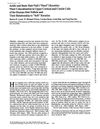TLDR Hair keratins are mainly on macrofibrils in the cortex and in the endocuticle in the cuticle.
The study utilized rapid-freezing immunocytochemistry to investigate the ultrastructural localization of hair keratins in human scalp hair shafts. This method, which involved rapid-freezing, freeze-substitution in acetone without chemical fixatives, and immunogold staining, preserved both the fine structure and antigenicity of hair keratins. The findings revealed that in the cortex, hair keratins were mainly located on the macrofibrils, while in the cuticle, they were primarily in the endocuticle, which lacked the fibrous structure of macrofibrils. This technique was deemed effective for examining the macromolecular architecture of fully keratinized human hair tissue.
61 citations
,
February 1997 in “Differentiation” Hair differentiation starts earlier than thought, involving multiple type-II keratins.
33 citations
,
October 1996 in “Journal of Investigative Dermatology” 52 citations
,
October 1995 in “Experimental Cell Research” Human hair keratin genes hHa2 and hHb1 are located on chromosomes 17 and 12.
20 citations
,
October 1995 in “Biochimica et Biophysica Acta (BBA) - Gene Structure and Expression” 21 citations
,
January 1995 in “Molecular Biology Reports” Scientists discovered two versions of a new human hair keratin gene.
35 citations
,
September 1994 in “Journal of Investigative Dermatology” 47 citations
,
June 1994 in “Experimental Cell Research” mHa2 and mHa3 keratins have different structures and roles in mouse hair and tongue tissues.
51 citations
,
March 1990 in “Journal of Investigative Dermatology” 198 citations
,
November 1989 in “The Journal of Cell Biology” Keratin K14 expression varies between hair follicles and epidermis, affecting cell differentiation.
248 citations
,
April 1988 in “Differentiation” Human and bovine hair follicles have distinct cytokeratins specific to hair-forming cells.
 356 citations
,
December 1986 in “The journal of cell biology/The Journal of cell biology”
356 citations
,
December 1986 in “The journal of cell biology/The Journal of cell biology” Hair and nail cells share similar proteins, indicating a common differentiation pathway.
81 citations
,
May 1986 in “Journal of Investigative Dermatology”
 5 citations
,
February 2019 in “PloS one”
5 citations
,
February 2019 in “PloS one” Bald thigh syndrome in sighthounds is caused by structural defects in hair shafts due to downregulated genes and proteins.
40 citations
,
April 1999 in “Journal of Histochemistry & Cytochemistry” S100A3 protein is mainly found in specific parts of human hair cells.
10 citations
,
January 2010 in “International journal of trichology” Keratin-associated proteins are part of the developing hair fiber cuticle.
 17 citations
,
December 2002 in “Biochemical and biophysical research communications”
17 citations
,
December 2002 in “Biochemical and biophysical research communications” Scientists found out how a specific protein in human hair cuticles behaves and is structured.
5 citations
,
September 2013



